service schedule Oldsmobile Aurora 1997 Owner's Manuals
[x] Cancel search | Manufacturer: OLDSMOBILE, Model Year: 1997, Model line: Aurora, Model: Oldsmobile Aurora 1997Pages: 404, PDF Size: 20.75 MB
Page 3 of 404
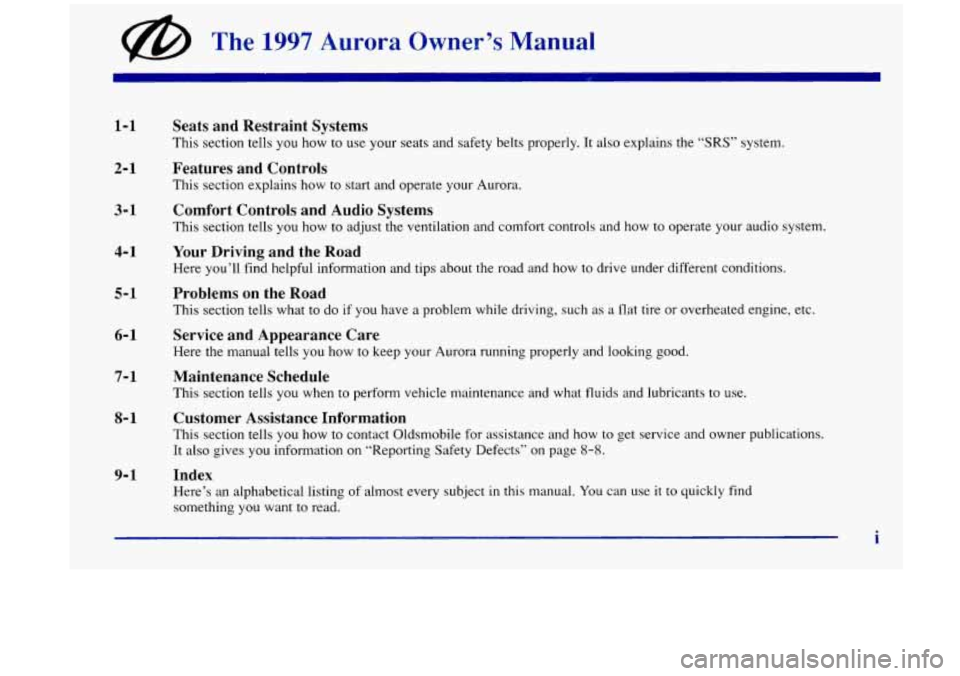
@ The 1997 Aurora Owner’s Manual
1-1
2-1
3-1 4-1
5-1
6- 1
7-1
8- 1
9-1
Seats and Restraint Systems
This section tells you how to use your seats and safety belts properly. It also explains the “SRS” system,
Features and Controls
This section explains how to start and operate your Aurora.
Comfort Controls and Audio Systems
This section tells you how to adjust the ventilation and comfort controls and how to operate your audio system.
Your Driving and the Road
Here you’ll find helpful information and tips about the road and how to drive under different conditions.
Problems on the Road
This section tells what to do if you have a problem while driving, such as a flat tire or overheated engine, etc.
Service and Appearance Care
Here the manual tells you how to keep your Aurora running properly and looking good.
Maintenance Schedule
This section tells you when to perform vehicle maintenance and what fluids and lubricants to use.
Customer Assistance Information
This section tells you how to contact Oldsmobile for assistance and how to get service and owner publications.
It also gives you information on “Reporting Safety Defects” on page
8-8.
Index
Here’s an alphabetical listing of almost every subject in this manual. You can use it to quickly find
something you want to read.
i
Page 214 of 404
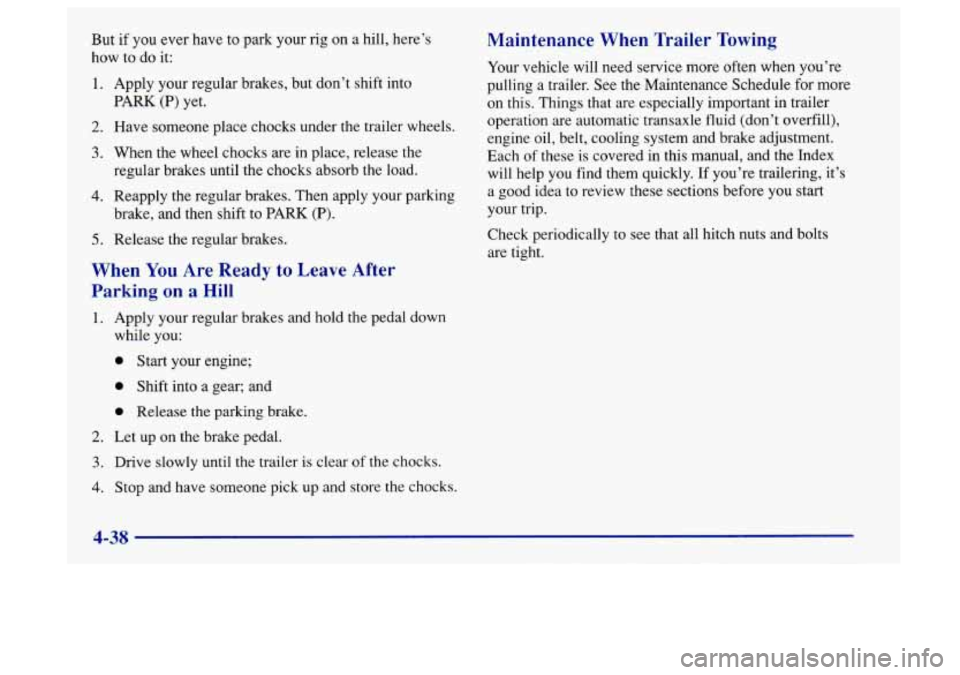
But if you ever have to park your rig on a hill, here’s
how to do it:
3. When the wheel chocks are in place, release the
regular brakes until the chocks absorb the load.
4. Reapply the regular brakes. Then apply your parking
5. Release the regular brakes.
brake,
and then shift to PARK
(P).
When You Are Ready to Leave After
Parking on a Hill
1. Apply your regular brakes and hold the pedal down
while you:
0 Start your engine;
0 Shift into a gear; and
0 Release the parking brake.
2. Let up on the brake pedal.
3. Drive slowly until the trailer is clear of the chocks.
4. Stop and have someone pick up and store the chocks.
Maintenance When Trailer Towing
Your vehicle will need service more often when you’re
pulling a trailer. See the Maintenance Schedule for more
on this. Things that are especially important in trailer
operation are automatic transaxle fluid (don’t overfill),
engine oil, belt, cooling system and brake adjustment.
Each
of these is covered in this manual, and the Index
will help you
find them quickly. If you’re trailering, it’s
a good idea
to review these sections before you start
your trip.
Check periodically to see that all hitch nuts and bolts
are tight.
4-38
Page 266 of 404
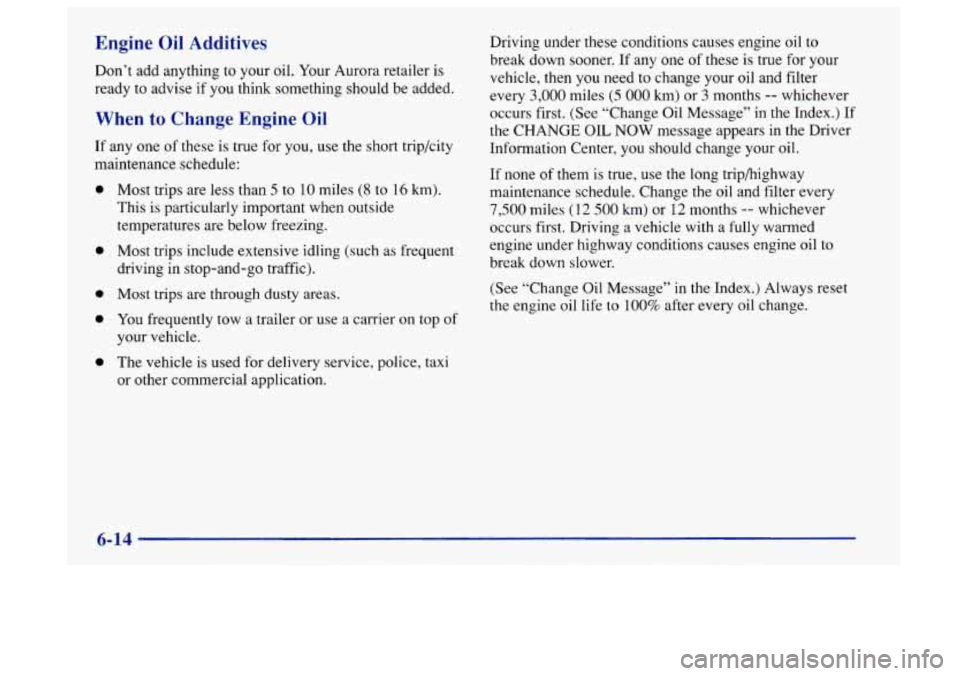
Engine Oil Additives
Don’t add anything to your oil. Your Aurora retailer is
ready to advise
if you think something should be added.
When to Change Engine Oil
If any one of these is true for you, use the short trip/city
maintenance schedule:
0
0
0
0
0
Most trips are less than 5 to 10 miles (8 to 16 km).
This is particularly important when outside
temperatures are below freezing.
Most trips include extensive idling (such
as frequent
driving in stop-and-go traffic).
Most trips are through dusty areas.
You frequently tow a trailer or use a carrier on top of
your vehicle.
The vehicle is used for delivery service, police, taxi
or other commercial application. Driving under
these conditions causes engine oil to
break down sooner.
If any one of these is true for your
vehicle, then you need
to change your oil and filter
every
3,000 miles (5 000 km) or 3 months -- whichever
occurs first. (See “Change Oil Message’’ in the Index.)
If
the CHANGE OIL NOW message appears in the Driver
Information Center, you should change your oil.
If none of them is
true, use the long triphighway
maintenance schedule. Change the oil and filter every
7,500 miles ( 12 500 km) or 12 months -- whichever
occurs first. Driving a vehicle with a
fully warmed
engine under highway conditions causes engine oil to
break down slower.
(See “Change Oil Message” in the Index.) Always reset
the engine oil life to 100% after every oil change.
6-14
Page 269 of 404
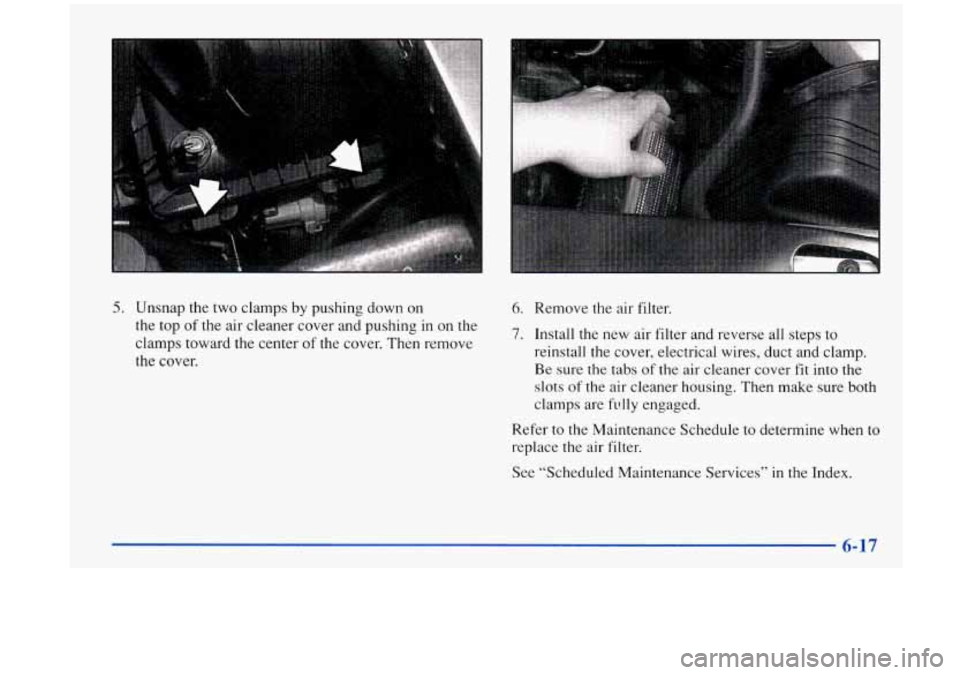
- , . .. .‘,. .
6. Remove the air filter. 5. Unsnap the two clamps by pushing down on
the top
of the air cleaner cover and pushing in on the
clamps toward the center
of the cover. Then remove
the cover. 7. Install the new air filter and reverse all steps to
reinstall the cover, electrical wires, duct and clamp.
Be sure
the tabs of the air cleaner cover fit into the
slots
of the air cleaner housing. Then make sure both
clamps are
fully engaged.
Refer
to the Maintenance Schedule to determine when to
replace the air filter.
See “Scheduled Maintenance Services”
in the Index.
6- 17
Page 270 of 404
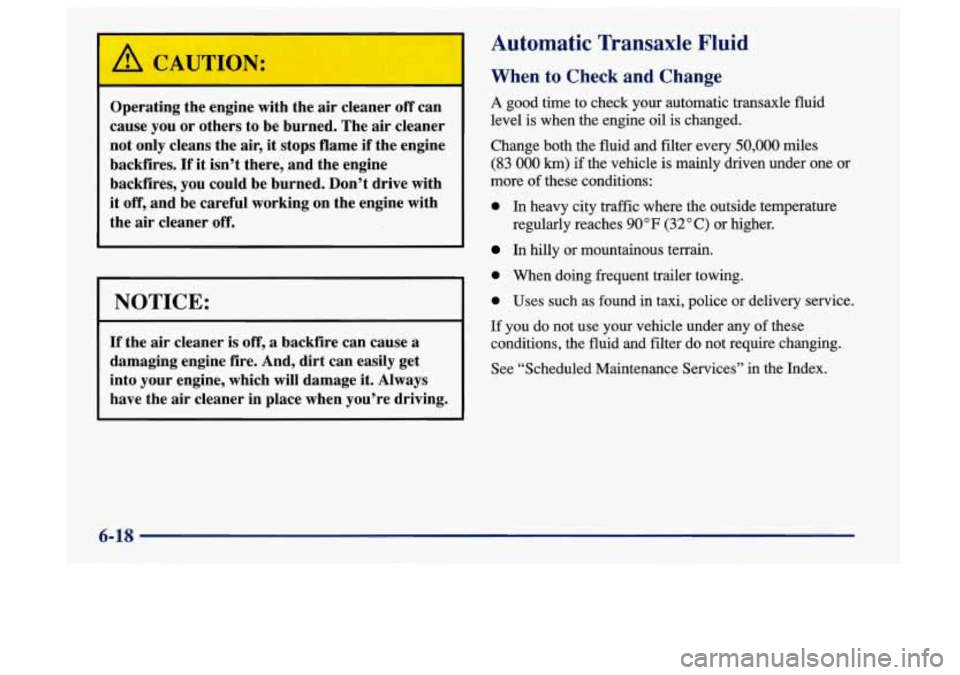
Operating the engine with the air cleaner off can
cause you or others to be burned. The air cleaner
not only cleans the air, it stops flame if the engine
backfires.
If it isn’t there, and the engine
backfires, you could be burned. Don’t drive with
it off, and be careful working on the engine with
the air cleaner
off.
NOTICE:
If the air cleaner is off, a backfire can cause a
damaging engine fire. And, dirt can easily get
into your engine, which will damage it. Always
have the air cleaner in place when you’re driving.
Automatic Transaxle Fluid
When to Check and Change
A good time to check your automatic transaxle fluid
level is when the engine oil is changed.
Change both the fluid and filter every
50,000 miles
(83 000 km) if the vehicle is mainly driven under one or
more of these conditions:
0 In heavy city traffic where the outside temperature
regularly reaches
90 OF (32 O C) or higher.
In hilly or mountainous terrain.
0 When doing frequent trailer towing.
0 Uses such as found in taxi, police or delivery service.
If you do not use your vehicle under any of these
conditions, the fluid and filter do not require changing.
See “Scheduled Maintenance Services” in the Index.
6-18
Page 298 of 404
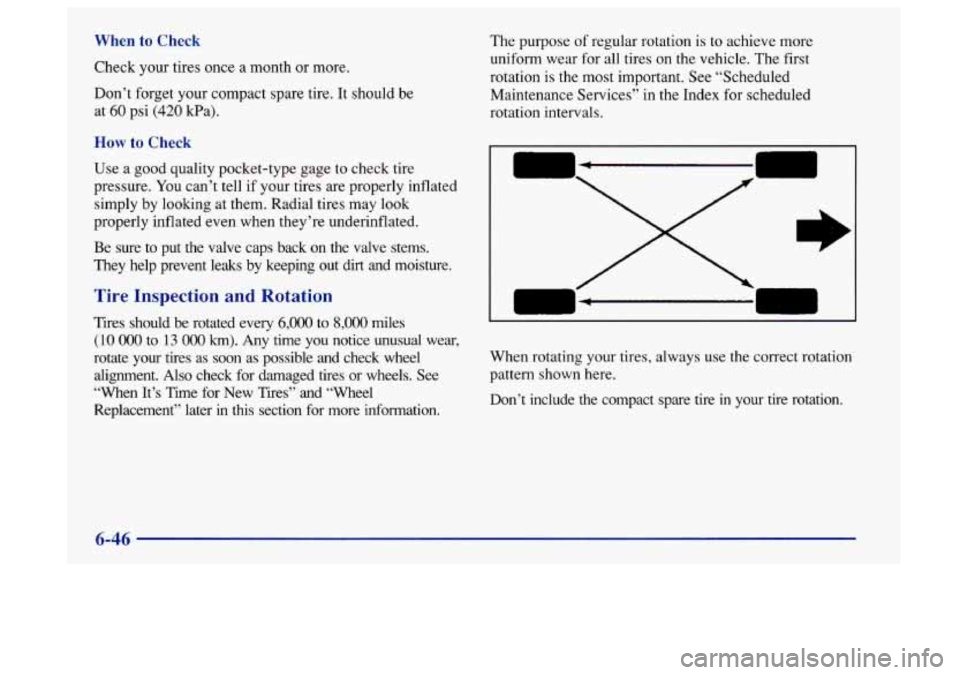
When to Check
Check your tires once a month or more.
Don’t forget your compact spare tire. It should be
at
60 psi (420 kPa).
How to Check
Use a good quality pocket-type gage to check tire
pressure. You can’t tell if your tires
are properly inflated
simply by looking at them. Radial tires may look
properly inflated even when they’re underinflated.
Be sure to put the valve caps back on the valve stems.
They help prevent leaks by keeping out dirt and moisture.
Tire Inspection and Rotation
Tires should be rotated every 6,000 to 8,000 miles
(10 000 to 13 000 km). Any time you notice unusual wear,
rotate your tires as soon as possible and check wheel alignment.
Also check for damaged tires or wheels. See
“When
It’s Time for New Tires” and “Wheel
Replacement’’ later
in this section for more information. The purpose
of regular rotation
is to achieve more
uniform wear for all tires on the vehicle. The first
rotation is the most important. See “Scheduled
Maintenance Services” in the Index for scheduled
rotation intervals.
When rotating your tires, always use the correct rotation
pattern shown here.
Don’t include
the compact spare tire in your tire rotation.
6-46
Page 329 of 404

Section 7 Maintenance Schedule
This section covers the maintenance required for your Aurora. Your vehicle needs these services to retain its safety,
dependability and emission control performance.
7-2
7-2
7-3
7-4
7-4
7-4 7-39
7-39
7-39
7-40
7-40
Introduction
Your Vehicle and the Environment
How This Section is Organized
Part
A: Scheduled Maintenance Services
Using Your Maintenance Schedule
Selecting the Right Schedule
Part B: Owner Checks and Services
At Each Fuel Fill
At Least Once a Month
At Least Twice a Year
At Least Once a Year
7-43
7-43
7-43
7-43
7-43
7-43
7-44
7-46 Part C: Periodic Maintenance Inspections
Steering, Suspension and Front Drive Axle
Boot and Seal Inspection
Exhaust System Inspection
Radiator and Heater Hose Inspection
Throttle Linkage Inspection
Brake System Inspection
Part D: Recommended Fluids and
Lubricants
Part
E: Maintenance Record
7-1
Page 331 of 404

How This Section is Organized
The remainder of this section is divided into five parts:
“Part
A: Scheduled Maintenance Services” shows
what to have done and how often. Some
of these
services can be complex,
so unless you are technically
qualified and have the necessary equipment, you should
let your retailer’s service department or another
qualified service center do these jobs.
L
Performing maintenance work on a vehicle can
be dangerous. In trying to do some jobs, you can
be seriously injured.
Do your own maintenance
work only if you have the required know-how
and the proper tools and equipment for the job.
If you have any doubt, have a qualified
technician do the work.
If you are skilled enough to do some work on your
vehicle, you will probably want to get the service
information
GM publishes. See “Service and Owner
Publications” in the Index. “Part
B: Owner Checks and Services”
tells you what
should be checked and when.
It also explains what you can
easily do to help keep your vehicle
in good condition.
“Part
C: Periodic Maintenance Inspections”
explains important inspections that your Aurora
retailer’s service department or another qualified service
center should perform.
“Part
D: Recommended Fluids and Lubricants” lists
some products
GM recommends to help keep your
vehicle properly maintained. These products, or their
equivalents, should be used whether you do the work
yourself
or have it done.
“Part
E: Maintenance Record” provides a place for
you
to record the maintenance performed on your
vehicle. Whenever any maintenance is performed, be
sure to write it down in this part. This will help you
determine when your next maintenance should be done.
In addition, it is a good idea to keep your maintenance
receipts. They may be needed to qualify your vehicle for
warranty repairs.
Page 332 of 404

Part A: Scheduled Maintenance
Services
Using Your Maintenance Schedule
We at General Motors want to help you keep your
vehicle in good working condition. But we don’t know
exactly how you’ll drive it. You may drive very short
distances only a few times a week. Or you may drive
long distances all the time in very hot, dusty weather.
You may use your vehicle in making deliveries. Or
you may drive
it to work, to do errands or in many
other ways.
Because
of all the different ways people use their GM
vehicles, maintenance needs vary. You may even need
more frequent checks and replacements than you’ll find
in the schedules in this section.
So please read this
section and note how you drive.
If you have any
questions on how to keep your vehicle in good
condition, see your Aurora retailer.
Selectinp the Right Schedule
rlrst you- 11 need to decide which of the two schedules is
right for your vehicle. Here’s how to decide which
schedule to follow:
This part tells
you the maintenance services you should
have done and when you should schedule them.
If you
go to your retailer for your service needs, you’ll know
that GM-trained and supported service people will
perform the work using genuine
GM parts.
The proper fluids and lubricants to use are listed in
Part D. Make sure whoever services your vehicle uses
these. All
parts should be replaced and all necessary
repairs done before
you or anyone else drives the vehicle.
These schedules are for vehicles that:
0 carry passengers and cargo within recommended
limits.
You will find these limits on your vehicle’s
Tire-Loading Information label. See “Loading Your
Vehicle”
in the Index.
are driven on reasonable road surfaces within legal
driving limits.
0 use the recommended fuel. See “Fuel” in the Index.
7-4
Page 333 of 404
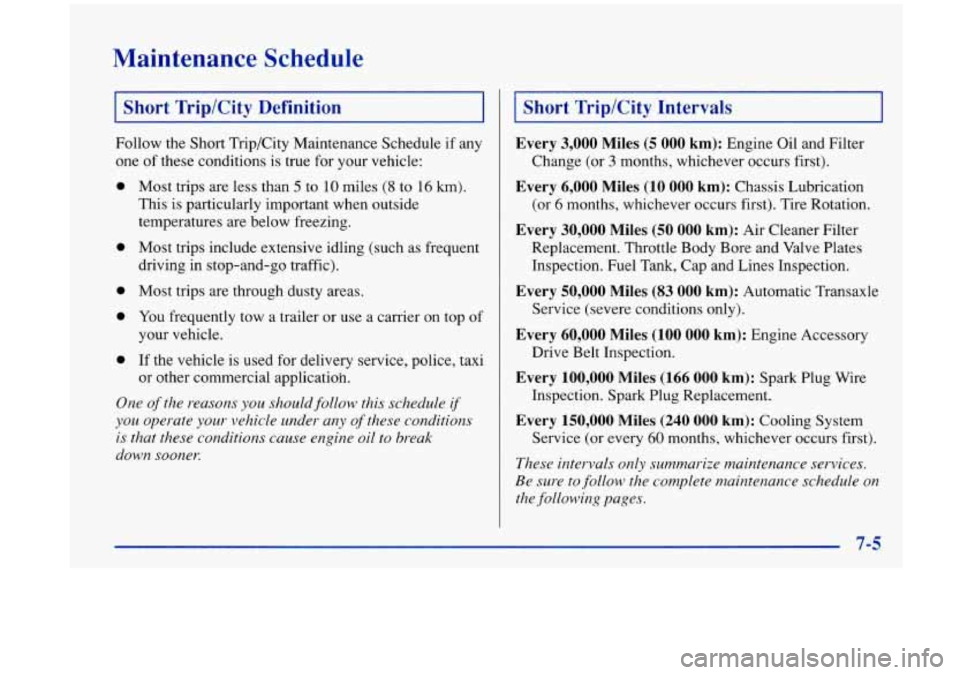
Maintenance Schedule
I Short Trip/City Definition I
Follow the Short Trip/City Maintenance Schedule if any
one of these conditions is true for your vehicle:
0
0
0
0
0
Most trips are less than 5 to 10 miles (8 to 16 km).
This is particularly important when outside
temperatures are below freezing.
Most trips include extensive idling (such
as frequent
driving in stop-and-go traffic).
Most trips are through dusty areas.
You frequently tow a trailer or use a carrier on top of
your vehicle.
If the vehicle is used for delivery service, police, taxi
or other commercial application.
One of the reasons you should follow this schedule if
you operate your vehicle under any of these conditions
is that these conditions cause engine oil to break
down sooner.
Short Trip/City Intervals
Every 3,000 Miles (5 000 km): Engine Oil and Filter
Change (or
3 months, whichever occurs first).
(or
6 months, whichever occurs first). Tire Rotation.
Every 6,000 Miles (10 000 km): Chassis Lubrication
Every 30,000 Miles (50 000 km): Air Cleaner Filter
Replacement. Throttle Body Bore and Valve Plates
Inspection. Fuel Tank, Cap and Lines Inspection.
Service (severe conditions only).
Every 50,000 Miles (83 000 km): Automatic Transaxle
Every 60,000 Miles (100 000 km): Engine Accessory
Every 100,000 Miles (166 000 km): Spark Plug Wire
Every 150,000 Miles (240 000 km): Cooling System
Drive Belt
Inspection.
Inspection. Spark Plug Replacement.
Service (or every
60 months, whichever occurs first).
These intervals only summarize maintenance services.
Be sure
to follow the complete maintenance schedule on
the following pages.